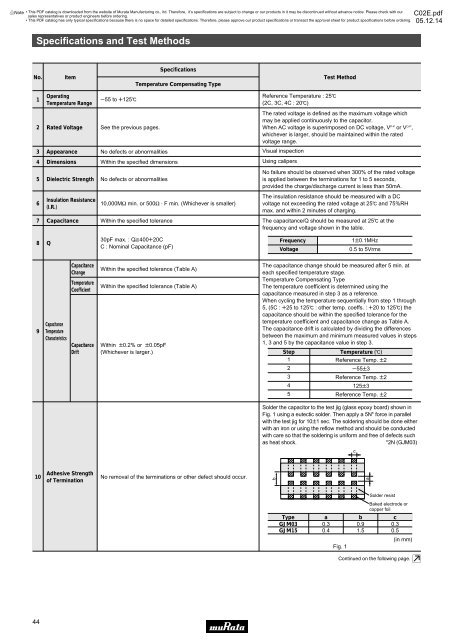Chip monolithic ceramic capacitors
Chip monolithic ceramic capacitors
Chip monolithic ceramic capacitors
Create successful ePaper yourself
Turn your PDF publications into a flip-book with our unique Google optimized e-Paper software.
!Note • This !Note PDF catalog • Please is downloaded read rating and from !CAUTION the website (for of Murata storage, Manufacturing operating, rating, co., ltd. soldering, Therefore, mounting it’s specifications and handling) are in subject this catalog to change to prevent or our smoking products and/or in it may burning, be discontinued etc. without advance notice. Please check with our<br />
sales representatives • This catalog or product has only engineers typical specifications before ordering. because there is no space for detailed specifications. Therefore, please approve our product specifications or transact the approval sheet for product specifications before ordering.<br />
• This PDF catalog has only typical specifications because there is no space for detailed specifications. Therefore, please approve our product specifications or transact the approval sheet for product specifications before ordering.<br />
C02E.pdf<br />
05.12.14<br />
Specifications and Test Methods<br />
No.<br />
Item<br />
Specifications<br />
Temperature Compensating Type<br />
Test Method<br />
1<br />
Operating<br />
Temperature Range<br />
Y55 to W125D<br />
Reference Temperature : 25D<br />
(2C, 3C, 4C : 20D)<br />
2<br />
Rated Voltage<br />
See the previous pages.<br />
The rated voltage is defined as the maximum voltage which<br />
may be applied continuously to the capacitor.<br />
When AC voltage is superimposed on DC voltage, V P-P or V O-P ,<br />
whichever is larger, should be maintained within the rated<br />
voltage range.<br />
3<br />
Appearance<br />
No defects or abnormalities<br />
Visual inspection<br />
4<br />
Dimensions<br />
Within the specified dimensions<br />
Using calipers<br />
5<br />
Dielectric Strength<br />
No defects or abnormalities<br />
No failure should be observed when 300% of the rated voltage<br />
is applied between the terminations for 1 to 5 seconds,<br />
provided the charge/discharge current is less than 50mA.<br />
8<br />
6<br />
7<br />
Insulation Resistance<br />
(I.R.)<br />
Capacitance<br />
10,000MΩ min. or 500Ω · F min. (Whichever is smaller)<br />
Within the specified tolerance<br />
The insulation resistance should be measured with a DC<br />
voltage not exceeding the rated voltage at 25D and 75%RH<br />
max. and within 2 minutes of charging.<br />
The capacitance/Q should be measured at 25D at the<br />
frequency and voltage shown in the table.<br />
8<br />
Q<br />
30pF max. : QU400W20C<br />
C : Nominal Capacitance (pF)<br />
Frequency<br />
Voltage<br />
1T0.1MHz<br />
0.5 to 5Vrms<br />
9<br />
Capacitance<br />
Temperature<br />
Characteristics<br />
Capacitance<br />
Change<br />
Temperature<br />
Coefficient<br />
Capacitance<br />
Drift<br />
Within the specified tolerance (Table A)<br />
Within the specified tolerance (Table A)<br />
Within T0.2% or T0.05pF<br />
(Whichever is larger.)<br />
The capacitance change should be measured after 5 min. at<br />
each specified temperature stage.<br />
Temperature Compensating Type<br />
The temperature coefficient is determined using the<br />
capacitance measured in step 3 as a reference.<br />
When cycling the temperature sequentially from step 1 through<br />
5, (5C : W25 to 125D : other temp. coeffs. : W20 to 125D) the<br />
capacitance should be within the specified tolerance for the<br />
temperature coefficient and capacitance change as Table A.<br />
The capacitance drift is calculated by dividing the differences<br />
between the maximum and minimum measured values in steps<br />
1, 3 and 5 by the capacitance value in step 3.<br />
Step<br />
Temperature (D)<br />
1<br />
Reference Temp. T2<br />
2<br />
Y55T3<br />
3<br />
Reference Temp. T2<br />
4<br />
125T3<br />
5<br />
Reference Temp. T2<br />
Solder the capacitor to the test jig (glass epoxy board) shown in<br />
Fig. 1 using a eutectic solder. Then apply a 5N* force in parallel<br />
with the test jig for 10T1 sec. The soldering should be done either<br />
with an iron or using the reflow method and should be conducted<br />
with care so that the soldering is uniform and free of defects such<br />
as heat shock.<br />
*2N (GJM03)<br />
c<br />
10<br />
Adhesive Strength<br />
of Termination<br />
No removal of the terminations or other defect should occur.<br />
a<br />
Solder resist<br />
Baked electrode or<br />
copper foil<br />
Type a b c<br />
GJM03 0.3 0.9 0.3<br />
GJM15 0.4 1.5 0.5<br />
Fig. 1<br />
(in mm)<br />
Continued on the following page.<br />
44


